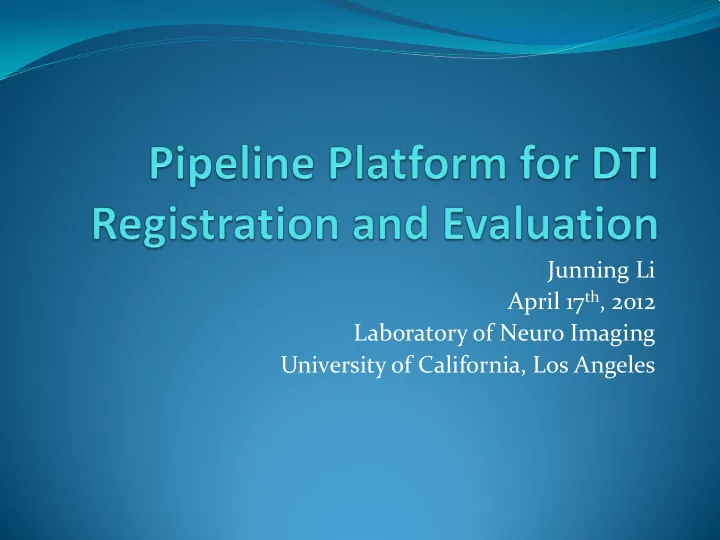

Junning Li April 17 th , 2012 Laboratory of Neuro Imaging University of California, Los Angeles
Background Water molecules in biology tissue tend to diffuse faster along, relative to across, obstacle structures such as fibers or membranes. Diffusion tensor imaging (DTI) measures this anisotropy, providing information about neural fibers. DTI registration is more complicated than intensity image registration , because tensor must be re-orientated during transformation. Evaluation of DTI registration is also complicated , involving eigen-analysis, matrix logorithm, tractography.
Motivations For developers of registration methods: “ How good is my new method in comparison with other methods?” “Can I work focus on the development of registration method, not distracted by building the evaluation environment by myself?” “How can I keep my files well organized so that I still can understand them some time later?” For users of registration methods: “ Can I trust the registration results I got and forward to group analysis in the template space?” “ Is there some outliers in my data that I should screen out?”
Software Environment for DTI Registration and Evaluation is Complicated A complicated workflow : Format conversion Tensor reconstruction Tractography Image Registration Warping of images and tracks Goodness evaluation Report of evaluation summaries statistics Many software packages using different data formats or coordinate systems involved: DTI-TK, TTK, DTK, Carmino, FSL, …
The Evaluation Environment Raw Data Preprocessor Registration Case Report A: Generator Tables and Registration Charts Method A Comparison Report Evaluation Module Registration Report B: Method B Tables and Charts
Functionality: Calculate transform. Smoothness: curvature, diffusion, affinity. Warp tensor images and compare FA, MD, RA, Euclidian difference, logarithm difference. Warp tracks and track distances.
Directory Tree Modules: Keep Files Organized and Names Consistent
Format Conversion Modules Functionality: Automatically convert tensor images to a different space and different coordinate systems. Automatically convert related files, such as brain masks and tracks.
Example Workflow Comments: Programming effort for evaluation is minimized. Develop just need to input fixed and moving images and tracks and transformation file into the evaluation module, a comprehensive evaluation result will be reported. Batch job is automatically distributed to computation clusters.
Example of Comparison Reports Junning Li, Yonggang Shi, Ivo Dinov, Jiongjiong Wang, Toga Arthur, “Fast Diffusion Tensor Registration with Exact Reorientation and Regularizaiton”, submitted to MICCAI 2012
Fixed Image Warped Image Example Images Moving Image
Recommend
More recommend